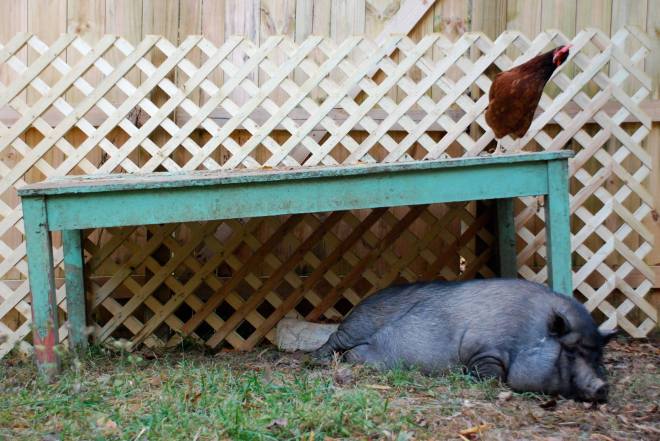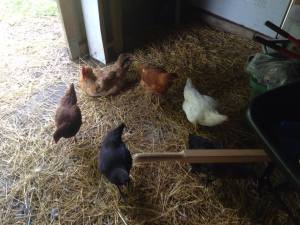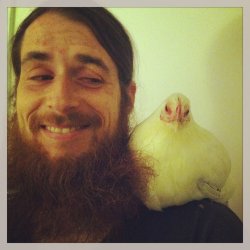I was recently interviewed by Kathryn Ashworth, a Producer at Yoga International, for a story she was doing on veganism and animal sanctuaries. Because of space limitations, only a portion of the interview made it into the final article, so Kathryn and I agreed to post the full text here for interested readers… ~ Justin

1. What is The Microsanctuary Movement? How is a sanctuary a state of mind?
The Microsanctuary Movement is an effort we started based on our work with Triangle Chance for All to help empower others to rescue farmed animals and self-identify as being part of a sanctuary, both through information and resources and through support networks. We are working on our website right now, but in the meantime we have been trying to share helpful tidbits through The Microsanctuary Movement’s Facebook page and our Facebook group, Vegans with Chickens. Through these and future means, we hope that the movement will inspire many vegans to rescue farmed animals, whether that be a rooster and some hens, or a few goats, or whatever species they can accommodate. To us, this is truly revolutionary because relying on large sanctuaries exclusively means limited ability to rescue farmed animals. Large sanctuaries can usually take in a few hundred animals at most, and so much of their income goes to administrative and other non-care costs. Comparatively, a few thousand vegans each rescuing a handful of animals would open up so much more space and (this is important) resources for care.
To answer the question about sanctuary being a state of mind, we have to first recognize that “sanctuary” is about how one cares for rescued animals and sees them as beings worthy of the utmost respect. Thus a microsanctuary centers on a space that is home to rescued animals and emphasizes their health and happiness. So someone with a rescued house rooster is just as much a sanctuary (by virtue of being a microsanctuary) as a million-dollar non-profit with hundreds of acres and hundreds of animals. I am frustrated by how self-limiting we all tend to be when it comes to our views of sanctuaries. I so often hear people say that they want to start their own sanctuary one day if they win the lottery, but without any clear idea of what “sanctuary” really means to them and how to get there. I was there once, and the notion of a typical sanctuary was so daunting that I did not even know where to start to make it happen. By throwing out the ideal, I was able to really think about what sanctuary means for the residents and the caregivers. It is a very powerful relationship and way of living, as well as a perspective on the world and our role as caregivers.
This sense of dedication to the service of rescued farmed animals, as a way to end (and help ameliorate in some way) their exploitation, is what lies at the heart of sanctuary—and on an individual level truly defines a microsanctuary. This is all about how we approach rescuing animals and accommodating them within our lives where we are now, not where we might be at some undetermined future time.
2. Can you give us an example of one animal you rescued and sheltered recently? How did you find them? What’s their story?
There are so, so many beautiful but poignant stories here at the TCA Microsanctuary, because each resident’s story reflects upon both their unique personality but also the exploitation by humans that they were rescued from. One of the dearest to our hearts is that of Bibi, a tiny little hen who came to us after her three flock-mates were killed by a raccoon who broke into the “chicken tractor” they all lived in in someone’s backyard. Bibi barely survived and was maimed in the attack: her top beak was partially bitten off, a hole was punched into her bottom beak, and she also lost part of a wattle. When she arrived, she was clearly suffering from PTSD; she spent several weeks just sitting in a bathroom like a lump. She started to come out of her shell when we put a mirror in with her, and then she really regained some of her spark when we brought in one of our other hens, Hypatia, to be a companion for her. Now she is a real fireball, with plenty of spunk and attitude. She has had to have several surgeries on her beak since then, and will likely always have trouble eating and require special attention, but she really rolls with the punches.
Bibi’s story highlights so many of the problems with backyard chicken-keeping (for example, she was part of a hatching project in which eight of the twelve chicks who were roosters and so were sent back to the farmer and most likely killed). We feel lucky to have gotten the opportunity to give her a better life.
Another story is that of Plutarch the piglet. Plutarch fell off a transport truck in transit and was taken to a rural animal shelter while still a tiny little guy. When one of our board members, Linda James, discovered him at the shelter, we started scrambling to find placement for him (because we knew we could not accommodate an 800-pound farm pig at our microsanctuary). Richard Hoyle at The Pig Preserve, an amazing sanctuary in Tennessee, stepped up and agreed to take Plutarch. TCA board members Linda and Alan Nelson fostered Plutarch for nearly a month, allowing him to grow bigger and stronger in a loving space, and then several board members transported Plutarch to The Pig Preserve in late December—where he is now the most rambunctious, joyful pig you will ever meet.
His story is sad for so many reasons—not just recognizing that he would have been killed in a matter of months for his flesh, but also realizing that he was stolen from his mother at such a young age and never got to know that nurturing parental love as he grew. Animal agriculture is a story of broken families as well as torture and death, and Plutarch’s experience makes that abundantly clear.
3. What do you mean when you say, “veganism is the only satisfactory response to the suffering of non-human animals”? What about humanely raised animals?
There is no “humane” way to eat or use a living being or the things that come from her body. There is a persistent effort in our society to assuage our discomfort with harming other animals by coming up with slightly less bad ways to do the things that make us uneasy. There is no longer any doubt that, as a species, humans can thrive on a plant-based diet and have no need to exploit other beings for our benefit. That recognition of our ability to live without directly harming other animals has to frame this entire discussion about whether or not it is possible to exploit those beings “nicely.”
It takes little time researching the practices of every agricultural industry to see that animals are commodities, not individuals. You cannot justify killing a living being who is not in pain many, many years before he or she would naturally die. But that very thing happens with cows, sheep, goats, chickens, turkeys, ducks, rabbits…any animal used for food, really. There is a vast difference between when an animal is at “market weight” (i.e., when they are old/large enough to slaughter for prime profits) and when an animal is at the end of their natural lifespan. Chickens can live up to 13 or 14 years, for example, yet “broiler” chickens raised for meat are slaughtered after six weeks. Even dairy cows, who are supposedly given a better life because they are not raised for meat, still end up as hamburger after their milk production declines after a few years. It makes no sense for a farmer or corporation to keep feeding, vetting, and otherwise dealing with an animal who is not at peak production. If you want proof of this, research what happens to “spent” laying hens, whether they are in battery cages or so-called “free-range” farms, once their egg production declines after a couple of years—if they even make it that far.
As for chickens naturally producing eggs, which is a common misconception, it is helpful to understand the biology of a modern domesticated hen. The wild ancestors of domesticated chickens, which are wild jungle fowl from South Asia, lay at most ten to fifteen eggs per year strictly for reproduction. In contrast, domesticated hens have been selectively bred and genetically altered by humans to produce 250-300 eggs per year. This genetic manipulation has turned hens into victims of their own biology, leaving them trapped in their own bodies, and it is directly responsible for the fact that most hens die before age five because of reproductive system complications (especially cancer). So to say a hen “naturally” produces the eggs humans eat is to utterly twist what “natural” actually means. There is nothing natural about a domesticated hens’ eggs, just as there is nothing ethical about eating them. Whenever a human eats a hens’ egg, whether it came from a battery cage or a backyard flock, they are perpetuating this inescapable suffering that hens endure.
Veganism is the only answer to this situation because there is no good way, no ethically defensible method or process, to exploit other beings for our benefit. Period. Once you accept the fact that animals exist for their own reasons, and have as much right to live as individuals with their own autonomy, then the question of how they are exploited is a moot one. One cannot exploit another being and pretend that one is being nice about it. One cannot justify using other animals when the only reason for doing so is personal tastes and habits and a refusal to look past the traditions and corporatized narratives telling us we need animal products to be healthy. To do otherwise is to turn individuals into objects, and that can never be justified.
4. What about people who say that they can’t afford to not eat meat due to health issues?
In almost all cases, health arguments for eating meat or other arguments are based on ignorance of actual human nutrition, an attempt to excuse away a desire to eat animal products, or a combination of similar factors. I recognize that some humans may have such severe health issues that eating a plant-based diet is extremely difficult, just as I recognize that many humans live in food deserts and have a huge challenge just finding adequate food to feed themselves and their families. But the majority of us have the capabilities, both in our physical needs and our resources, to stop eating animal products. This is even true for athletes who put their bodies in much more rigorous and demanding physical conditions. There are vegan ultra-marathoners, bodybuilders, mixed martial arts fighters, NFL football players… It is abundantly clear, looking at living breathing humans, that being athletic does not prohibit being vegan.
5. How do animals, particularly the ones we classify (culturally) as less important (pigs, chickens, cows… etc.) give your life meaning? Why do you connect with them as individuals when so many see them as food?
Being vegan for us is centered on the idea that other animals deserve as much respect and consideration as our fellow humans. Living with and rescuing animals (in particular farmed animals), however, reflects the fruition of our ethical principles put into practice. This is especially true for farmed animals because all of us, even vegans, have accepted the idea that they are somehow different than dogs, cats, and the other species we classify as “companions.” They live on farms somewhere out in the country and are owned by farmers … unless they are lucky and go to a big farm sanctuary that is also out in the country and run by a different sort of farmers.
It would be hard for us to pinpoint a reason why we connect with farmed animals as individuals, except to say that it is an entirely impossible task for us to do otherwise. Humans have desensitized themselves to violence and exploitation, in particular by compartmentalizing them so as to ignore or forget them. We, and other ethical vegans, are not able to do that any longer. Taking that to the next level, we are committed to helping as many animals as we can get the respect that they deserve by getting them out of the exploitative systems they are trapped in. Getting involved with farmed animal rescue and care has led to a profound shift in how we see ourselves as vegans. It is no longer so much a negative orientation, in the sense that we are trying to not cause harm or not be part of exploitation. It feels so much more positive to have a direct role in and responsibility for the care of the very individuals for whom we went vegan. All of us at Triangle Chance for All are and always have been vegan for the animals; saving and sustaining the lives of as many of them as we can has given our veganism so much more depth, meaning, and relevance.
6. What do you think it will take to finally convince people that this is a social crisis? Is the solution simply a matter of leading by example?
We have to do the work and reach the humans we can but not wait on others to make change happen. This means focusing on helping the victims of human greed as much as possible while also advocating on their behalf. It often seems that no one ever listens, and that we are losing the battle to make a society that is kind to all beings. But whether or not we achieve our goals, we have to do the work and strive as hard as we can. Otherwise we can be sure we will lose.
I do not think leading by example is enough, though it is important. We have to feel within ourselves the urgency of non-human animal liberation because it is far too easy to deprioritize or forget their suffering. Empathy is important, but it is not the same as experiencing what they do, and I think this is a large part of why so little has actually changed with how humans treat other animals. So I think “what it will take” is some sort of crisis that makes consuming animals immediately harmful or impossible. Even with as many vegan products and resources as we have available now, vegans are still a tiny minority (about 2.5% or so) of the American population, and this is true globally as well. It is not a matter of practicalities.
I try hard not to be a pessimist with this whole issue. Humans have a hard time acknowledging crises until they significantly affect the humans (especially the humans with the most power and privilege) themselves. That is why it is so crucial for those of us who do get it to both advocate to other humans and act to make change happen for the individuals who suffer—whether that means helping others go vegan or rescuing animals from exploitation. Advocacy and leading by example are not enough; activism, whatever that means for you (be it protests, disruptions, leafleting, rescuing animals…), has to be a key part of how we live in the world as vegans.
7. Do you practice yoga? If so, how does your practice influence your activism?
That depends on how you define yoga, I suppose. If you mean mat work, Rosemary and I, as well as board member Linda Nelson, practiced yoga for years before starting TCA. We all saw yoga as a practice while also taking seriously the principles behind it. For example, ahimsa is a principle of not harming that (we feel) provides an imperative for being vegan. This is why Jivamukti Yoga, for example, includes veganism as a component of the practice. It is a shame that more modern yoga traditions and practitioners do not recognize this.
You could also see what we do as a form of karma yoga, of course. As someone who studied and practiced Buddhist meditation for many years, as well as yoga, I feel very strongly that our “practice” is most important when it is actualized through our ways of living in the world. What we do in private on our mats or our cushions should be a foundation for how we live in and influence the world around us. We should also do more to acknowledge how intentional acts of service, compassion, and justice are essential components of a practice of ahimsa.



 Please share your story of going vegan. When did you make the transition, and what motivated you to stop using animals for your own benefit?
Please share your story of going vegan. When did you make the transition, and what motivated you to stop using animals for your own benefit?









